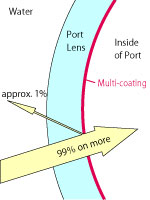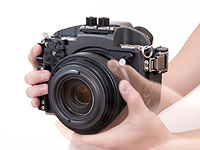
A multi-coating optical glass lens is totally different from a simple water-proof glass and is required highest homogeneity and transmissivity, precised refractive index and dispersing property to pursue sharp and clear images after clearing strict quality control including;
- Well selected material
- Prolonged polishing in manufacturing
- Optical performance test
The multi-coating prevents decrease of permeable light to suppress ghost, flare caused by surface reflection.
A lens port without multi-coating will loose approximately 5% of total transmitted light by reflection due to difference of refractive index between air and a lens at inner surface of the lens.
Also inside of the lens port will cause ghost or flare by inner reflection.
So using a lens port without multi-coating or not using optical glass will inevitably lead to images, especially wide images with whity color tone or less sharpness especially just below surface in backlit.

without multi-coating

with multi-coating
<Surface Reflection of Port Lens>
A port lens without multi-coating will loose approximately 5% of total transmitted light by reflection at air interface (inside of a port). An INON port will decrease this loss within 1% which will greatly enhance image quality even with such a marginal difference in reflection ratio.
[Flare]
Flare is the light intricately scattered inside of a lens and could reduce contrast of an image, exposed as partial whity or chromatic aberration.
[Ghost]
Particular type of flare observed when taking a photo with bright light source like the sun in image area where circular or polygon light marking appears on the line joining the light source and the center of an image.
[Coating]
Thin layers with less refractive index to reduce surface reflection on a lens. Combination of different characteristic single coat to increase light transmission is referred to multi-coat.
[Optical glass]
Particular glass used for an optical products like a camera, lens telescope etc., which is required highest homogeneity and transmissivity, precised refractive index and dispersing property.
Though it is not too many things to do to press a shutter-release button at the "decisive moment" with intended composition, appropriate exposure and in focus to obtain an inspired image, it is difficult and this becomes much more complicated underwater.
Capturing the decisive moment underwater has to be depending on equipments even more than diving skill. Off course we need to put a camera in an underwater housing to use underwater. Then do we only need a bulky water-proof box with a shutter lever, button and grip? This will do only to take an image underwater but far from to capture the decisive moment. An underwater housing should not be a simple water-proof box.
Most of the housings support focusing by using mechanical gear on a lens and control by turning a small knob on the left hand side of the housing or port. With this type of underwater housing, the left hand can not hold the housing and the right hand has to be under strain leading to less sensitivity on the right index finger to operate the shutter lever.
The INON unique MRS (Magnetic Rotary System) port uses magnet ring on a lens instead of a mechanical gear and focusing is controlled only by rotating a
"MRS Control Ring" on a lens port by magnetic attraction. The "MRS Control Ring" turns the focus ring on a lens at equal rate where we can control the lens with same gear ration/torque as like controlling the lens on land. When controlling the MRS Control Ring, the left hand holds the lens port from underneath, which helps to avoid overload on the right hand.
Holding the camera body by the right hand and controlling the lens barrel by the left hand is exactly same style as shooting on land.
Focusing system using mechanical gear requires specific gear to use powerful teleconverter but MRS port only needs an optional Extension Ring.




